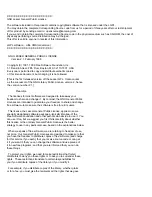
Custom Device Monitoring Programming
51
RMS NetLinx Programmer’s Guide
RMS_STAT_NOT_ASSIGNED (1),
RMS_STAT_HELP_REQUEST (2),
RMS_STAT_ROOM_COMM_ERR (3),
RMS_STAT_CONTROLSYSTEM_ERR (4),
RMS_STAT_MAINTENANCE (5),
RMS_STAT_EQUIPMENT_USAGE (6),
RMS_STAT_NETWORK_ERR (7),
RMS_STAT_SECURITY_ERR (8).
One of these values classifies a fault with this parameter as a Help Request,
Room Communication Error, Control System Error, Maintenance, Equipment
usage, Network Error, or Security issue.
bReset and slResetValue, nResetValue or cResetValue are used to allow the
administrator to manually reset the value. If bReset if False, then then
slResetValue, nResetValue and cResetValue are ignored.
nInitialOp and slInitial, nInitial and cInitial are used to set the value of the
parameter at the time it is registered. nInitialOp can be one of the following
values:
RMS_PARAM_SET (0),
RMS_PARAM_INC (1),
RMS_PARAM_DEC (2),
RMS_PARAM_MULTIPLY (3),
RMS_PARAM_DIVIDE (4),
RMS_PARAM_UNCHANGED (6).
This eliminates the need to send a separate set parameter messages after the
parameter is registered. These constants allow you to control whether the
supplied value is set, added to, subtracted from, multiply with, divided by the
number in the database or if you simply want the value in the database to remain
the same. slInitial, nInitial and cInitial are the value with which the operation will
be performed.
slMin, slMax and eEnumList are used to limit the administrator’s selection of the
threshold and reset values. The "|" character is used to separate values in the
Summary of Contents for RMS 3.0
Page 1: ...Software NetLinx Programmer s Guide RMS Resource Management Suite 3 0 ...
Page 4: ......
Page 10: ...Overview 2 RMS NetLinx Programmer s Guide ...
Page 12: ...System Requirements 4 RMS NetLinx Programmer s Guide ...
Page 22: ...Concepts 14 RMS NetLinx Programmer s Guide ...
Page 62: ...Custom Device Monitoring Programming 54 RMS NetLinx Programmer s Guide ...
















































